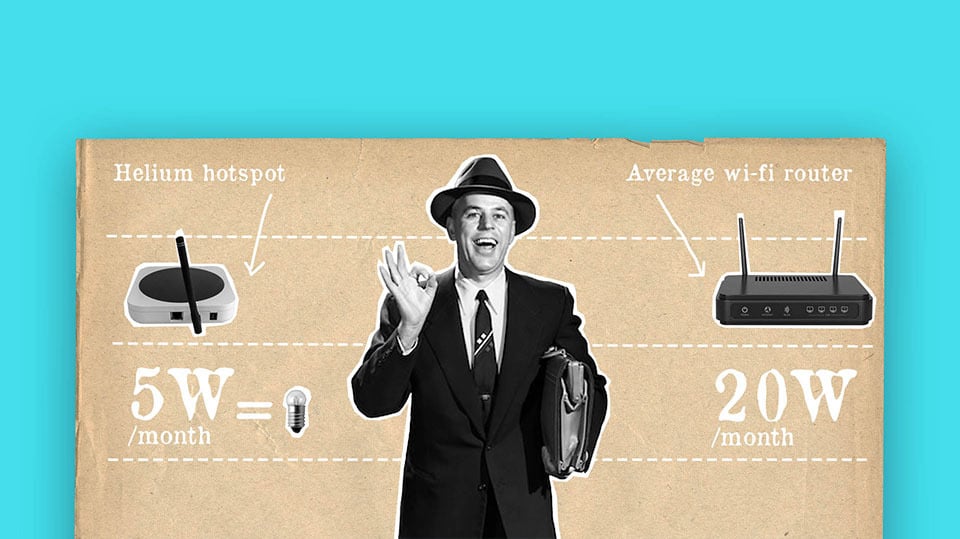
Cryptocurrency miners have long searched for easy and affordable ways to generate passive income. It seems like their dream has come true.
Helium Network broke the internet recently with a simple idea: let’s mine cryptocurrency by providing wireless internet coverage for the Internet of Things (IoT). Furthermore, it came up with a simple and cost-effective device, a Helium Hotspot Miner, which brought cryptocurrency mining closer to broad audiences.
Sponsored
This Helium Hotspot miner review will discuss more about how Helium mining works, why it is so popular, and how profitable it could be.
What Is Helium?
Helium blockchain aims to create a global decentralized wi-fi network for smart devices and is powered by a very new incentive model. Also called People’s Network, Helium builds the network of users, who provide coverage for Internet of Things (IoT) devices to connect to the Internet and communicate with each other.
Thousands of physical IoT devices surround us every day: be it smartwatches, pet collars, smart light bulbs, GPS locators, medical sensors, or fitness trackers. They could be anything that supports internet and is able to interact with other devices through a wireless connection.
Sponsored
However, smart devices require a reliable connection between them to operate at their full capacity. The problem is, they could exist at a distance from each other, and wi-fi connections only provide short-distance coverage. Moreover, wi-fi networks are already highly occupied by computers or smartphones.
Helium Network tries to solve the IoT internet coverage problem. It adopts radio wave-based technology, which is sufficient to deliver long-distance network coverage for smart devices. As a reward for that, Helium network rewards coverage providers with its native currency, Helium Network Token (HNT).
What Is the Helium Hotspot Miner?
The Helium Hotspot miner is the original HNT currency mining device. It is small, portable hardware similar to a wi-fi router. Hotspots create the global wireless network that operates under the Proof-of-Coverage algorithm and enables monetizing the IoT device data.
The hotspot miner uses Helium’s LongFi technology to provide long-range wireless network coverage for smart devices that work in a low-power mode.
LongFi is a new type of wireless protocol that is capable of covering 200 times the distance of wi-fi. It was created by Helium, which transfers data over long ranges and maximizes the battery life of compatible devices. It is based on LoRaWAN (Low-Power Wide-Area Network) functionality and is capable of covering broad territories.
As said, the Helium Hotspot mining device only uses 5W of energy and is much cheaper compared to mobile internet costs. Anyone with a hotspot can create the network or add a smart device to it.

How Does Helium Hotspot Miner Work?
Each hotspot provides wireless coverage and operates as a node that helps to mine Helium Tokens (HNTs). This is done through the specifically built algorithm called Proof-of-Coverage (PoC). The mining here enables several ways to earn Helium’s crypto.
First, Helium Hotspots utilize radio waves that work as the validation and help to prove that a certain hotspot really provides network coverage for smart devices. Each node (hotspot) then gets rewarded with HNTs for contribution.
Secondly, each Helium hotspot miner earns Helium Tokens for sending data through the hotspot’s network. This means the more data gets transferred (i.e. more smart devices are covered), the higher the HNT earnings.
To fully enable Helium Hotspot mining features, each hotspot miner has to use Date Credits (DC). These are dollar-pegged tokens with a fixed value of $0.00001. They are fundamental in the Helium network and act similarly as a prepaid mobile plan’s top-up. The hotspot user pays in Data Credits for sending information to the internet from hundreds of smart devices.
Data Credits are created by “burning” Helium Tokens. This means the more Data Credits are used, the more deflationary the HNTs become.
Helium Hotspot Miner Features
The official Helium Hotspot Miner is no longer produced and available. However, there are multiple third-party HNT Hotspot miners compatible with Helium LongFi.
There is a list on the Helium website where you can find all the manufacturers, including Bobcat Miner 300, RAK Hotspot Miner v2, or Nebra. They all are programmed to support the Helium blockchain, as only officially certified devices can mine HNTs.
Ease of Use
Mining Helium Tokens with a hotspot is one of the easiest ways to mine cryptocurrency. The process is very simple and only requires the miner to place the device in the right wide-open space, connect to the internet, download the Helium App for iOS or Android, and then set up the device through the mobile app, which only takes a few minutes. That’s it. You can use the app to monitor and control the mining process remotely or follow other Helium miners.
In this step, the biggest challenge is to find the right place for a Helium Mining device. It’s best to place it near the window. The higher the better. The hotspot miner has to have access to wide-open space for its best performance.
Cost-Effectiveness
The cost of a Helium mining device depends on the manufacturer. However, the standard price level is around $400 at the time of writing.
The technical specifications of different hotspots also come in very similar ranges. The majority of Helium Hotspot miners are low-power devices that use low levels of energy.
They mostly require around 5W to connect to the internet, which converts to 0.12kWh or 3.6kWh per month. The electricity usage is similar to 5W LED bulbs and is very low compared to the amounts of energy required for Bitcoin, Ethereum, or other cryptocurrency mining. The average wi-fi router, in the meantime, consumes up to 20W of energy.
However, within peak time, Helium Hotspot mining devices might consume up to 12W (or 0.288 kWh), which converts to almost 8.64kWh per month. Taking the average $0.137 electricity price of the United States, this would only cost around $1.20 per month.
Profitability
No matter the manufacturer, each Helium Hotspot miner generates the most earnings when it operates in an area with a dense concentration of IoT devices. Even placed in a semi-populated area, each hotspot mining unit may generate up to $50 per day. The rewards could be bigger if there are other miners around.
Keep in mind that two hotspots located closer than 300-350 meters apart, reduce the mining profitability. Helium Hotspots provide long-range coverage, and thus if placed too close, they will compete and take profit from each other.
In the meantime, hotspots that are placed further than 300-350 meters benefit one another. This is because HNT earnings depend on the value the hotspot gives to the network. Hotspots surrounded by neighbors can validate their wireless coverage and earn higher rewards.

On The Flipside
- The supply of HNT tokens is fixed; only 223 million HNTs will be ever minted. The network went through its first halving on August 1st, 2021, when HNT issuance was reduced to 2.5 million Helium tokens per month. Helium network halvings are set to happen every two years.
- Helium network coverage increased up to 200K hotspots worldwide within the past year. It is growing rapidly and might affect coverage density and miners’ earnings over time, especially in highly saturated areas.
Why You Should Care?
Internet of Things has huge future potential. And so do the services around it. Crypto mining by providing wireless coverage for smart devices is a new idea. Besides, offering a simple and affordable way to earn passive income, the Helium network makes cryptocurrency mining available for a mass audience.
